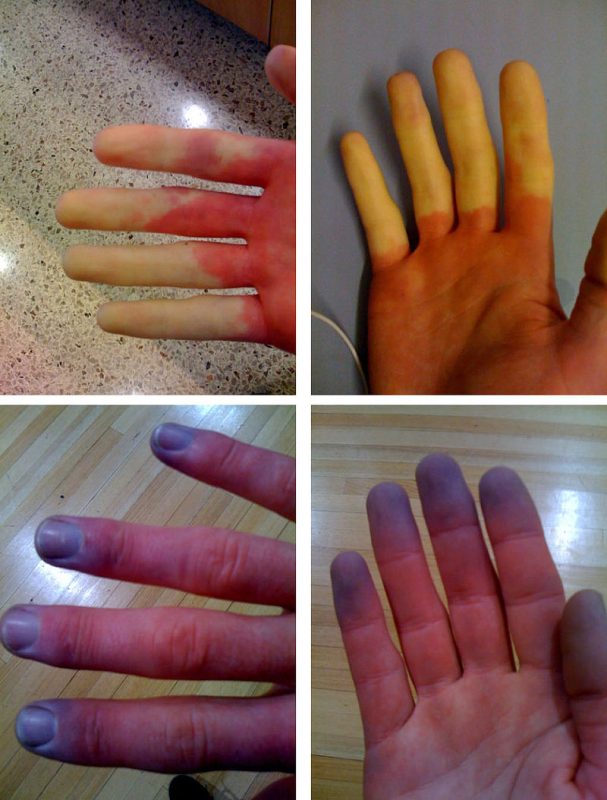
Raynaud phenomenon
Contents:
Overview of the Raynaud phenomenon
Raynaud's phenomenon is a condition in which the blood vessels in the extremities narrow, which restricts blood flow. Episodes or "attacks" usually affect the fingers and toes. Rarely, seizures occur in other areas, such as the ears or nose. An attack usually occurs from exposure to cold or emotional stress.
There are two types of Raynaud's phenomenon - primary and secondary. The primary form has no known cause, but the secondary form is associated with another health problem, especially autoimmune diseases such as lupus or scleroderma. The secondary form tends to be more severe and requires more aggressive treatment.
For most people, lifestyle changes, such as staying warm, keep symptoms under control, but in severe cases, repeated attacks lead to skin ulcers or gangrene (tissue death and breakdown). Treatment depends on how serious the condition is and whether it is primary or secondary.
Who Gets Raynaud's Phenomenon?
Anyone can get Raynaud's phenomenon, but it is more common in some people than others. There are two types, and the risk factors for each are different.
Company primary a form of Raynaud's phenomenon, the cause of which is unknown, has been associated with:
- Sex. Women get it more often than men.
- Age. It usually occurs in people younger than 30 and often begins in adolescence.
- Family history of the Raynaud phenomenon. People who have a family member who has Raynaud's phenomenon have a higher risk of getting it themselves, suggesting a genetic link.
Company secondary a form of Raynaud's phenomenon occurs in association with another disease or environmental exposure. Factors associated with secondary Raynaud's include:
- Disease. Among the most common are lupus, scleroderma, inflammatory myositis, rheumatoid arthritis, and Sjögren's syndrome. Conditions such as certain thyroid disorders, bleeding disorders, and carpal tunnel syndrome are also associated with the secondary form.
- Medications. Medicines used to treat high blood pressure, migraines, or attention-deficit/hyperactivity disorder may cause symptoms similar to Raynaud's phenomenon or worsen underlying Raynaud's phenomenon.
- Work-related exposures. Repeated use of vibrating mechanisms (such as a jackhammer) or exposure to cold or certain chemicals.
Types of Raynaud's Phenomenon
There are two types of Raynaud's phenomenon.
- Primary Raynaud phenomenon has no known cause. This is the more common form of the disease.
- Secondary Raynaud phenomenon associated with another problem such as a rheumatic disease such as lupus or scleroderma. This form may also be based on factors such as exposure to cold or certain chemicals. The secondary form is less common but usually more severe than the primary due to damage to the blood vessels.
Symptoms of Raynaud's Phenomenon
Raynaud's phenomenon occurs when episodes or "fits" affect certain parts of the body, especially the fingers and toes, causing them to become cold, numb, and discolored. Exposure to cold is the most common trigger, such as when you take a glass of ice water or take something out of the freezer. Sudden changes in ambient temperature, such as entering an air-conditioned supermarket on a warm day, can trigger an attack.
Emotional stress, cigarette smoking, and vaping can also cause symptoms. Parts of the body other than the fingers and toes, such as the ears or nose, may also be affected.
Raynaud attacks. A typical attack develops as follows:
- The skin of the affected body part becomes pale or white due to lack of blood flow.
- The area then turns blue and feels cold and numb as the blood left in the tissues loses oxygen.
- Finally, as you warm up and circulation returns, the area becomes red and may swell, tingle, burn, or throb.
At first, only one finger or toe may be affected; then it can move to other fingers and toes. The thumbs are affected less frequently than the other fingers. An attack can last from a few minutes to several hours, and the pain associated with each episode can vary.
Skin ulcers and gangrene. People with severe Raynaud's phenomenon may develop small, painful sores, especially on the tips of their fingers or toes. In rare cases, a prolonged episode (days) of lack of oxygen to the tissues can lead to gangrene (cell death and decay of body tissues).
In many people, especially those with the primary form of Raynaud's phenomenon, the symptoms are mild and do not cause much concern. People with the secondary form tend to have more severe symptoms.
Causes of Raynaud's Phenomenon
Scientists don't know exactly why some people develop Raynaud's phenomenon, but they do understand how seizures happen. When a person is exposed to cold, the body attempts to slow heat loss and maintain its temperature. To do this, the blood vessels in the surface layer of the skin constrict (narrow), moving blood from vessels near the surface to vessels deeper in the body.
In people with Raynaud's syndrome, the blood vessels in the arms and legs react to cold or stress, constrict quickly, and remain constricted for a long period of time. This causes the skin to turn pale or white and then turn blue as the blood left in the vessels is depleted of oxygen. Eventually, when you warm up and the blood vessels dilate again, the skin turns red and can tingle or burn.
Many factors, including nerve and hormonal signals, control blood flow in the skin, and Raynaud's phenomenon occurs when this complex system is disrupted. Emotional stress releases signaling molecules that cause blood vessels to constrict, so anxiety can trigger an attack.
Primary Raynaud's phenomenon affects more women than men, suggesting that estrogen may play a role in this form. Genes may also be involved: the risk of the disease is higher in people who have relatives, but specific genetic factors have not yet been conclusively identified.
In secondary Raynaud's phenomenon, the underlying condition is probably damage to the blood vessels due to certain diseases, such as lupus or scleroderma, or work-related exposures.
Leave a Reply